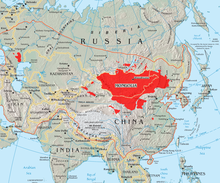Mongolien leid
The "Scots" that wis uised in this airticle wis written bi a body that haesna a guid grip on the leid. Please mak this airticle mair better gin ye can. |
| Mongolien | |
|---|---|
| монгол хэл | |
| Pronunciation | /mɔŋɢɔ̆ɮ xeɮ/ |
| Native tae | Mongolie |
| Region | Aw o state Mongolie an Inner Mongolie; Buryatia, Kalmykia, pairts o Irkutsk Oblast, Zabaykalsky Krai in Roushie; pairts o Liaoning, Jilin, Heilongjiang, Xinjiang, Gansu an Qinghai provinces in Cheenae; Issyk-Kul Region in Kyrgyzstan |
Native speakers | 5.2 million (2005)[1] |
Mongolic
| |
Early forms | |
Staundart forms | Khalkha (Mongolie)
Chakhar (Cheenae)
|
| Dialects | |
| Mongolie alphabets: Tradeetional Mongolie alphabet (in Cheenae), Mongolie Cyrillic alphabet (in Mongolie), Mongolie Braille | |
| Offeecial status | |
Offeecial leid in | |
| Regulatit bi | Mongolia: State Leid Cooncil,[3] China: Council for Language and Literature Work[4] |
| Leid codes | |
| ISO 639-1 | mn |
| ISO 639-2 | mon |
| ISO 639-3 | mon – inclusive codeIndividual codes: khk – Khalkha Mongoliemvf – Peripheral Mongolie (part) |
| Glottolog | mong1331[5] |
| Linguasphere | part of 44-BAA-b |
 Geografic distribution o Mongolic fowks athort Asie (reid) | |
The Mongolien leid ( ![]() , Mongγol kele; Cyrillic: Монгол хэл, Mongol khel ) is the best-kent member o the Mongolic leid family. It haes aboot 5.7 million speakers, includin ower 90% o the residents o Mongolie[6] an mony o the Mongolien residents o the Inner Mongolie autonomous region o Cheenae. In Mongolie, the Khalkha dialect o Mongolien, written in Cyrillic, is predominant; in Inner Mongolie, the leid is mair dialectally diverse an written in the traditional Mongolien script.
, Mongγol kele; Cyrillic: Монгол хэл, Mongol khel ) is the best-kent member o the Mongolic leid family. It haes aboot 5.7 million speakers, includin ower 90% o the residents o Mongolie[6] an mony o the Mongolien residents o the Inner Mongolie autonomous region o Cheenae. In Mongolie, the Khalkha dialect o Mongolien, written in Cyrillic, is predominant; in Inner Mongolie, the leid is mair dialectally diverse an written in the traditional Mongolien script.
Mongolien haes vouel hermony an a complex seellabic structure for a Mongolic leid that allous up tae three seellable-final consonants. It is a typical agglutinative leid that relies on suffix chains in the verbal an nominal domains. While the basic wird order is subject–object–predicate, the noun phrase order is relatively free, so functional roles are indicatit bi a seestem o aboot aicht grammatical cases. Thare are five voices. Verbs are marked for voice, aspect, tense, an epistemic modality/evidentiality. In sentence linkin, a special role is played bi converbs.
Modren Mongolien evolved frae "Middle Mongolien", the leid spoken in the Mongol Empire o the 13t an 14t centuries. In the transition, a major shift in the vouel hermony paradigm occurred, lang vouels developed, the case seestem wis slichtly reformed, an the verbal seestem wis restructured.
References
[eedit | eedit soorce]- ↑ Estimate from Svantesson et al. 2005: 141.
- ↑ "China". Ethnologue.
- ↑ "Törijn alban josny helnij tuhaj huul'". MongolianLaws.com. 15 Mey 2003. Archived frae the original on 22 August 2009. Retrieved 27 Mairch 2009. Unknown parameter
|dead-url=ignored (help) The decisions of the council have to be ratified by the government. - ↑ "Mongγul kele bičig-ün aǰil-un ǰöblel". See Sečenbaγatur et al. 2005: 204.
- ↑ Nordhoff, Sebastian; Hammarström, Harald; Forkel, Robert; Haspelmath, Martin, eds. (2013). "Mongolian". Glottolog. Leipzig: Max Planck Institute for Evolutionary Anthropology.
- ↑ "Ethnologue, Mongolia page". Archived frae the original on 7 Julie 2010. Retrieved 11 Julie 2010.
| This Asie-relatit airticle is a stub. Ye can help Wikipaedia bi expandin it. |
| This leid-relatit airticle is a stub. Ye can help Wikipaedia bi expandin it. |